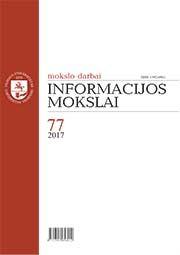Kultūros paveldo informacijos pusiau automatinis valdymas ir tyrimai naudojant 3D technologijas
The Semi-Automated Management of Cultural Heritage Information and Investigations in Implementing 3D Technologies
Author(s): Rimvydas Laužikas, Albinas Kuncevičius, Valentas Kurauskas, Tadas Žižiūnas, Ramūnas Šmigelskas, Renaldas Augustinavičius, Egidijus ŽilinskasSubject(s): Archaeology, Cultural history, Museology & Heritage Studies, Electronic information storage and retrieval, Methodology and research technology
Published by: Vilniaus Universiteto Leidykla
Keywords: 3D laser scanning; auto-image recognition; monitoring of urban areas; cultural heritage; archaeology; pilgrimage;
Summary/Abstract: The identification, investigation and preservation of cultural heritage is one of the main challenges for contemporary society. It’s closely connected with several dimensions: technology transfer, scientific investigations, global-local rhetoric, cultural tourism, armed conflicts, immigration, cultural changes, investment flows, new transport infrastructures etc. Nowadays, organizations responsible for heritage investigation and management are very often forced to deal with a lack of resources, which are crucial for proper heritage identification, investigation and preservation, as well as their maintenance and protection. It is particularly problematic for countries with low GDP or an unstable political situation. The possible solution of these problems could be an information management-based methodology connected with an automated and semi-automated heritage investigation and monitoring software system, which based on 3D technologies. Two cases of cultural heritage (burial mounds and old towns) and two system prototypes are presented in this article. The first prototype – The System of Automated Detection of Prehistoric Burial Mounds Margo was developed and tested by Vilnius University as a part of the project The Beginnings of Lithuanian Statehood According to the Exploration of the Dubingiai Microregion (2011–2015); the other prototype was developed and tested by Vilnius University and Terra Modus Ltd. in frame of the project The Creation of Automated Urban Heritage Monitoring Software Prototype (2014). In this article, we present the main results of both projects. 3D scanning technology is the most accurate method of finding the heritage objects in a natural landscape and capturing the situation of an evolving cultural heritage object or complex at a given time. As a cultural heritage object or complex is evolving continuously, two 3D point clouds created at different time allow to reliably trace potential changes. The monitoring of large scale heritage complexes, such as urban heritage objects, is a resource demanding task and in such cases a semi-automatic, computer-based 3D visual analysis is appropriate. A comparison of 3D visual data, captured during different times, advances to a next level when utilizing methods of 3D photogrammetry, which make it possible (at least partially) to create 3D point clouds from old photos, giving us opportunities to expand research by adding empirical data captured before 3D scanning equipment and also lowering the costs of conducting such research.
Journal: Informacijos mokslai
- Issue Year: 2017
- Issue No: 77
- Page Range: 160-179
- Page Count: 20
- Language: Lithuanian

